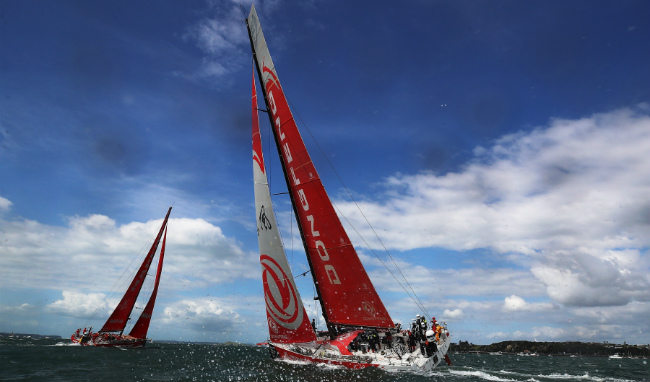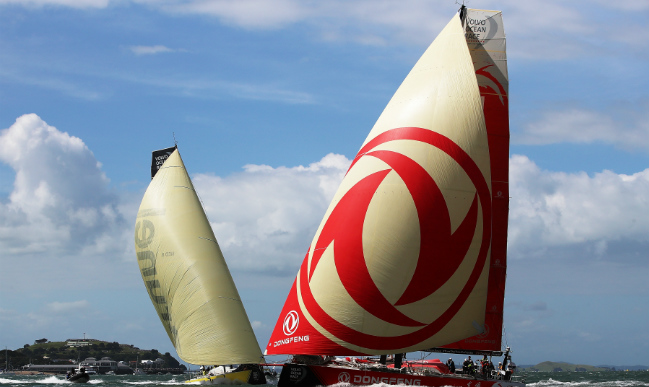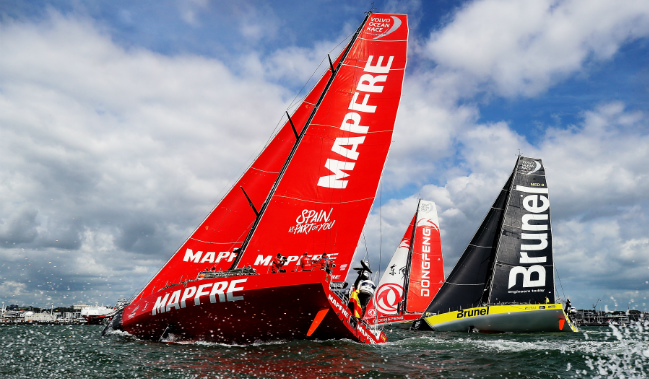
Wind worn, wave beaten, and pushed to their very limits, just finishing is an accomplishment for those who compete in the Volvo Ocean Race. Consider this — you say goodbye to your family for nine months, live on a boat, sleep (when your body lets you) on a bunk, and face all types of weather in the most far-flung places on earth. Depending on the wind, or lack of it, your speed maxes out at 35 knots (40 miles per hour), and it’s between you and six other boats to pursue the next checkpoint.
Only a select few would embrace such a rare challenge. The race occurs — most recently in October of 2017 for its 13th installment — every three years, bringing together Olympic-style international spirit and a competition of the highest stakes, all while testing aspects of technical advancement, experience, and physical training. Spanning 45,000 nautical miles and reaching five continents, the teams complete 11 legs with stopovers in each port city, beginning off of the southeastern coast of Spain in Alicante.
Back in 2012, Chinese auto manufacturer Dongfeng entered the sport, putting together a campaign for the 2014 race. Three years later, Dongfeng’s team came out on top in the most remarkable finish in the race’s history.
Assembling a team for the Ocean Race involves and worldwide search for the best at their respective craft on the high seas. Enter Charles Caudrelier, a 44-year-old Frenchman who won the Tour de Bretagne at 27, finished first in the 2004 Solitaire de Figaro, and won the 2012 Ocean Race with Goupama. Dongfeng tapped him to skipper the team, due mainly to the fact that he’d proven himself able to win while also pushing young sailors to compete at veteran levels.
“It starts with passion,” Caudrelier told Uproxx Sports. “You need someone with that sensation, because it’s all about managing the speed of the wind, the feeling of the boat and after that it’s all in your mind. When you take a decision sometimes, it’s all about handling the stress and the pressure.”
Teaming up with Caudrelier would be 47-year old New Zealander Stu Bannatyne, who has seven Ocean Races under his belt with three wins. Bannatyne’s knowledge of the race and the expectations for the crew would provide the steady presence essential in the role of the team’s driver.
“There was an emphasis this time on making it more of an international team,” Bannatyne says. “It was the introduction of a few different sailors from previous races like myself, Daryl (Wislang) from New Zealand, and Carolijn (Brouwer). So that just builds on the experience of the previous team.”
With a crew assembled around a diversity of skill and perspectives, along with success from previous campaigns — not only in the Ocean Race, but also the Olympics and America’s Cup — Dongfeng was positioned to challenge the other boats while assuming the role of dark horse to win the race. Tactical expertise serves teams well, as all of the boats were of one design: the Volvo Open 70.

Also significant to this edition of the Ocean Race, for the first time in its history, women were able to the competition. For Brouwer, the 44-year-old mother of a seven-year old, it was her skipper’s message in his pitch that sold her on joining Dongfeng.
“Of course you have to be a good sailor and have a good set of skills,” Brouwer says of Caudrelier’s approach to his crew. “He said ‘It’s more about who you are as a person than how much you can do,’ and that was the key, to me, to everything.”
Skill and experience aside, the true challenge of the race lies in the mental wiring of each sailor. At times isolated in parts of the globe with no signs of life, led by the whim of weather miles away from land and a world away from families and loved ones, it is every part of a nine month grind.
“You’re going to spend nine months of your life on a boat in the remote places of earth with each other,” Brouwer says. “So you have to trust and respect each other. You don’t have to be the best of friends. You’ve got to be able to get on the boat without carrying a backpack full of problems.”
That chemistry would be the lifeblood for Caudrelier and the Dongfeng team as the boats set sail from Spain, first to Lisbon and then south to Cape Town. Through the fall and winter months, the course took the boats through the Indian Ocean on to Melbourne.
Team performance manager Neil Maclean-Martin, who is responsible for the sailors’ physical performance and function, points to the first few legs that were the most grueling for Dongfeng.
“Early on in the race, going from Cape Town to Melbourne was brutal,” Maclean-Martin recalls, “It was faster than expected, but had huge seas and big winds the whole time. So there was very little sleep, it was hard to eat and you’re making lots of maneuvers.”
In early February, the course led up to Hong Kong, then back south to Auckland in March, followed by a long stretch across the Southern Ocean to Itajai, Brazil by mid April.
As the weeks and miles ticked off, each leg brought consistent results for Dongfeng. The boat held up and the crew competed tenaciously, but no legs were won. In this supreme test of wills, where conditions test one’s psyche, the nourishment of success propels efforts forward.
Team director Bruno Dubois, the mastermind behind Dongfeng, was well aware of the rigors of the race his sailors would endure. The 58-year-old Belgian had a vision of a team that would bond as the competition intensified, gaining strength over time rather than fading through the nine grueling months.
“The lowest point was probably Hong Kong,” Dubois said of race’s course. “It was hard physically and mentally for the team to go through. Newport was hard because we did a great leg, and then eight miles from the finish, we were just passed by three boats.”
While luck for the team was seemingly up in the air with the ocean winds, Caudrelier, Bannatyne, and company would have to trust their strategy and their instincts.
“Sailing is a weird sport, in that there’s a lot that you’re really not in control of,” Bannatyne admits. “Things don’t always go to plan. You can’t get too happy, you can’t get to sad. Every day of every leg and every watch, we just execute the plan.”
Despite not standing atop the winner’s podium at the end of the first ten legs, the Dongfeng crew found solace in a consistent boat and their ability to contend with the leading teams MAPRE and Brunel. Entering the last two legs in Cardiff and Gothenburg, a victory would appear to be eluding the team in just their second Ocean Race. If things were to work out for Dongfeng, they were going to have to happen soon.
“When I won in 2011, we had the strongest team on paper,” Caudrelier recalls. “Very good sailors, the best boat for sure, and it was tough to win because in the end, people were not always working together.”
With Dongfeng, Dubois and Caudrelier had a balanced and experienced crew, plus three young Chinese sailors — Chen Jinhao, Xue Liu, and Yang Jiru — determined to prove themselves to their country and make a statement in the sport. As the race went on, the team would take merit in their efforts as a unit, despite not reaching any of the ten checkpoints first.

By mid-June, the race had come down to the 11th and final leg. Despite their inability to place first, Donfeng’s total elapsed time kept them among the leaders, MAPFRE and Team Brunel. Before they launched from Gothenberg for a 970-mile push to the finish line located on the western coast of the Netherlands in The Hauge, Caudrelier’s strategy would require the ultimate test of the team’s trust.
Nine months at sea, through the most extreme conditions, the race would come down a dead heat for the three teams with the finish line in sight. Instead of an all-out sprint between the three boats, Dongfeng’s plan was to break off from the pack and go inshore to take advantage of the optimal wind angle through shallower waters. This also meant the boat would immediately fall off from the lead, some 50 miles.
“It was an all or nothing leg,” Bouwer said of their approach to the finish. “Our weather router, Marcel van Treist, he really pushed for this and believed in it. He said ‘your time, your gain is going to come in the end,’ and that just repeated in my head.”
Through the night, with MAPFRE and Brunel ahead of them, it appeared all was lost for Dongfeng. Then, in the wee hours of the race’s final day, Caudrelier received the news from his shore team that he had hoped for: Dongfeng was closing on the leaders, moving fast and gaining in the rankings.
After 243 days of sailing, it would come down to the final six hours on Sunday. If the wind held, Dongfeng would have the speed to pass the other two boats on the last stretch to the finish line.
On shore in The Hauge’s race village, during an overcast and windy day amid a musical-festival spirited atmosphere, the thousands of spectators stood shoulder-to-should, filling the beach and lining the docks to witness the race’s greatest finish.
“We had a clear idea to go inshore,” Caudrelier adds. “It was in strong winds and we just did what we thought was the right choice.”
The wind did hold, Dongfeng had its gain and cruised on to the finish line ahead of the MAPFRE boat by three miles.
“I can say that we studied that route in much greater detail than any of the other teams,” Maclean-Martin admits. “It was literally the last 15 minutes before we could say it was going to be ours.”
So there it was, the most dramatic finish the Ocean Race had ever seen by team with the most to prove and largest statement to make. And as you would imagine winning a race after nine months at sea, the celebration was equal parts championship locker room, wedding reception, and graduation day. Champagne soaked the deck of the team base, and as is oftentimes the case when teams achieve the ultimate glory, “We Are the Champions” echoed through the harbor into the early hours of Monday morning.






